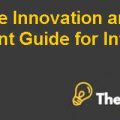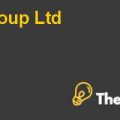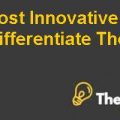Mcdonald Corporation Case Study Solution
External Analysis
Environmental Analysis (PESTEL Analysis)
Political
There are a number of political forces affecting McDonalds, due to its global presence. The governmental policies related to food i.e. provision of halal food in the Arabian countries, increases the intensity of political forces for McDonalds. Moreover, the governmental policies related to tax, trade etc. are also political forces affecting business at McDonalds.(Alanzi, 2018)
Economic
As the company operates in more than 30 countries, it faces diverse economic forces. The economic conditions, the purchasing power of consumers, the inflation rate and the exchange rate are certain economic forces impacting McDonalds’ generation of revenues and its profit margin.
Social
Social forces affecting McDonalds includes the consumer preferences of food. Different people in different countries prefer different types of food. These unique preferences of people have forced the McDonalds to conduct unique adaptations, with introduction of beef free food in India, and Halal food in Arab countries.
Technological
Technological forces affecting McDonalds is the introduction of advanced cooking equipment i.e. microwaves etc., and the advanced accounting as well as counter machines across the world. Improvement in technology has enabled the company to acquire an operational efficiency, without compromising on the quality.
Environmental
The environmental forces include the concerns of environmental community over the health of people, and the safety of environment. The concerns of labor activist and other environmental groups tend to rise the people’s perception about the health factor of the food being offered by McDonald’s
Legal
Legal forces affecting McDonalds include the governmental regulations over the introduction of a franchise in various countries, tax regulations, and the rules over environmental safety etc.
Market Analysis
The overall market condition for McDonalds is somehow favorable. There is a number of giant competitors of McDonalds,operating in the market, which include; Burger King, Wendy, Taco Bell, Subway etc. However, the economic recovery from the global recession of 2008 has revived the market and the consumers’ purchasing power by providing a ray of hope for the restaurant industry. The consumers are shifting towards healthy products, which is also a positive point for McDonalds, as it is focused on providing healthy foods to its consumers. Moreover, the products cost for healthy foods are higher as compared to the normal food. The bargaining power of suppliers of the material required for healthy food provision is high, due to the lack of suppliers in the market.
Alternative Strategies
Strategy-1: Expand to Potential Markets
McDonalds could expand into certain potential markets i.e. Asian markets, to increase its consumer base. The expansion in Asian market can increase the consumer base of the company, and would allow McDonalds to achieve sustainable sales growth. However, it would require a large amount of investment, and time, for implementation.
Strategy-2: Introduce Low-End Products in the Menu
Introduction of low-end products in the menu would allow the company to target the low-end consumer market segment, to increase its consumer base and achieve the sales growth. It would not require much efforts and investment, however, it could result in the shift of McDonald’s focus form its target market,and possess a risk of failure.
Strategy-3: Eliminate Non-Selling Products in the Menu
McDonalds could eliminate the non-selling products form its menu in order to decrease the complexity of its menu, which is the major cause behind McDonalds having an increased serving time. However, the implementation of this strategy would require a proper analysis of consumer preferences regarding the various items being offered by McDonalds.
Strategy-4: Conduct Effective Marketing Strategies
The effective marketing strategies would enable the company to attract the consumers and sustain its current consumer base. It would also enable McDonalds to build its market position as a company, which is dedicated in providing healthier food items at affordable prices.
Strategy-5:Introduce Coffee Parlors beside Its Franchises
McDonald could initiate coffee parlors by introducing its MacAfee, and other specialty coffee flavors for the purpose of attracting a large number of consumers towards its restaurants. However, the introduction of coffee parlors would require a substantial amount of investment, and an extensive research to be conducted.
Recommendations
On the basis of deep analysis of internal and external factors of McDonalds; the company is recommended to pursue the strategy 2, 3 and 4 on the prior basis in order to have instant results. It should first eliminate non-selling items from its menu, and incorporate new items in its menu. After that, it should conduct aggressive marketing strategies with the new menu in the low-end and high-end market segments, to attract new consumers. The marketing strategies should be focused on attracting new customers, along with building a market position of McDonalds as a company, which provides healthy food. The effective implementation of these strategies would enable the company to increase its profit margins and achieve a sustainable sales growth. After an effective implementation of these strategies; the company could pursue the other strategies of expanding towards potential markets, and the introduction of coffee parlors. In this way, McDonalds could have the possibility and higher chances of reviving its financial position, and its stock prices in the market, and it would also be able to have a long term market position.
Conclusion
Although, McDonalds is currently facing acute internal and external challenges in terms of declining sales growth and profit margins, operational complexity, intense market competition etc. but, all these challenges or issues could be tackled by taking certain critical strategic steps to turnaround the overall business conditions of McDonalds. By conducting aggressive marketing strategies and introducing new products in the menu etc., McDonalds could revive its market position, and gain potential profit margins.
Appendices
Appendix-1: SWOT Analysis
| Strengths | Weaknesses | Opportunities | Threats |
| · Long term existence in the local and foreign markets.
· Vast geographical presence. · Investment in technologies. · Large number of restaurants. · Unique Adaptations · Cost cutting measures.
|
· Premium Prices
· Operational Complexity · Inability to |
· Expansion towards more potential regions.
· Introduction of low-end products in current menu. · Introducing coffee parlors beside McDonald’s franchise. |
· Decline in the market share.
· Reduction in the current sales and profit levels. |
Appendix-2: Horizontal Analysis
| Horizontal Analysis | ||||
| Fiscal Year | 2013 | 2014 | 2015 | 2016 |
| Cash and short-term investments | 20% | -26% | 270% | -84% |
| Receivables (total) | -4% | -8% | 7% | 13% |
| Property, plant and equipment (net total) | 4% | -5% | -6% | -8% |
| Depreciation and amortization (accumulated) | 6% | 0% | 0% | -10% |
| Assets (total) | 4% | -6% | 2% | -11% |
| Accounts payable (trade) | -5% | -21% | 2% | -14% |
| Long -term debt | 4% | 6% | 61% | 7% |
| Liabilities (total) | 0% | 6% | 44% | 8% |
| Stockholder's equity (total) | 5% | -20% | -45% | -131% |
| Sales (net) | 2% | -2% | -7% | -3% |
| Cost of goods sold | 2% | -2% | -8% | -8% |
| Selling general and admin expenses | -3% | 4% | -2% | -2% |
| Income Taxes | 0% | 0% | -22% | 8% |
| Income before extraordinary items | 2% | -15% | -5% | 3% |
| Net Income (loss) | 2% | -15% | -5% | 3% |
Appendix-3: Vertical Analysis
| Vertical Analysis | |||||
| Fiscal Year | 2012 | 2013 | 2014 | 2015 | 2016 |
| Cash and short-term investments | 8% | 10% | 8% | 30% | 5% |
| Receivables (total) | 5% | 5% | 4% | 5% | 6% |
| Property, plant and equipment (net total) | 90% | 92% | 89% | 91% | 86% |
| Depreciation and amortization (accumulated) | 50% | 52% | 53% | 57% | 54% |
| Assets (total) | 128% | 130% | 125% | 137% | 126% |
| Accounts payable (trade) | 4% | 4% | 3% | 3% | 3% |
| Long -term debt | 49% | 50% | 55% | 95% | 105% |
| Liabilities (total) | 73% | 72% | 78% | 121% | 135% |
| Stockholder's equity (total) | 55% | 57% | 47% | 28% | -9% |
| Sales (net) | 100% | 100% | 100% | 100% | 100% |
| Cost of goods sold | 56% | 56% | 56% | 56% | 53% |
| Selling general and admin expenses | 9% | 8% | 9% | 10% | 10% |
| Income Taxes | 9% | 9% | 10% | 8% | 9% |
| Income before extraordinary items | 20% | 20% | 17% | 18% | 19% |
| Net Income (loss) | 20% | 20% | 17% | 18% | 19% |
Appendix-4: PESTEL Analysis
| Political | Economic | Social | Technological | Environmental | Legal |
| · Regulations related to the food ingredients.
· Policies related to tax. · Governmental policies related to foreign companies. |
· Income level of consumer.
· Economic conditions of the country. · Exchange rate. |
· Food preferences of people in the different regions.
· Religious diversities. |
· Technological advancement in kitchen materials.
· Technological Advancement in accounting equipment. |
· Concerns over people health.
· Concerns over environmental safety. |
· Tax Regulations
· Environmental regulations. · Food Regulations i.e. Halal |
This is just a sample partical work. Please place the order on the website to get your own originally done case solution.










